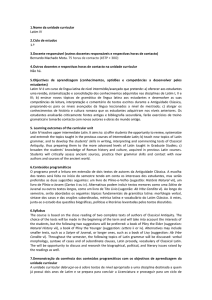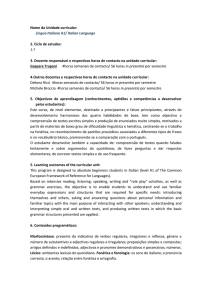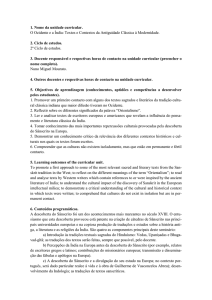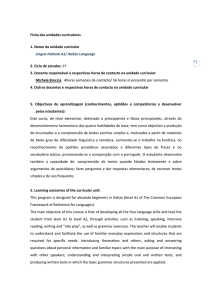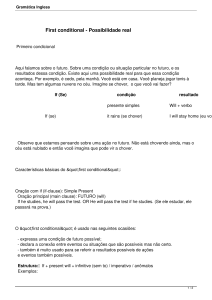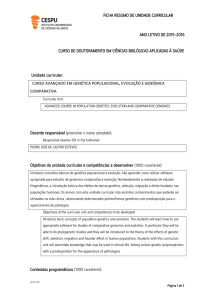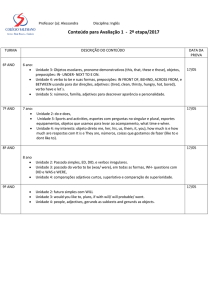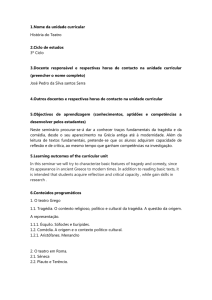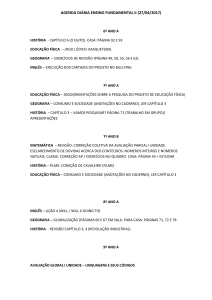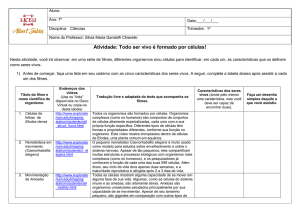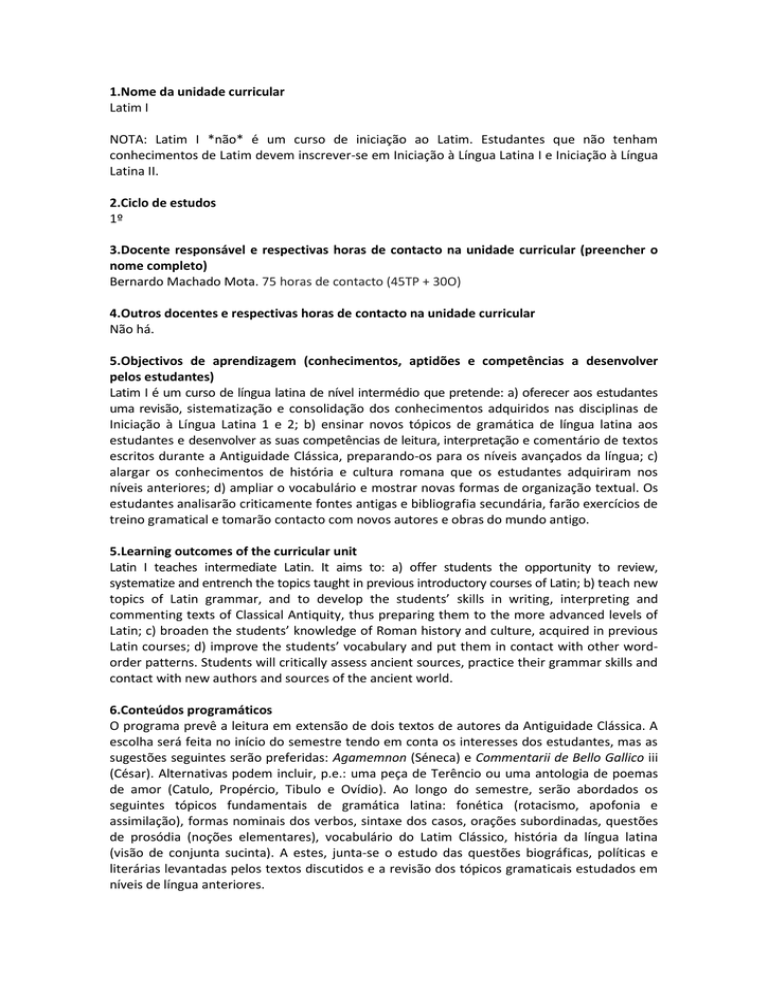
1.Nome da unidade curricular
Latim I
NOTA: Latim I *não* é um curso de iniciação ao Latim. Estudantes que não tenham
conhecimentos de Latim devem inscrever-se em Iniciação à Língua Latina I e Iniciação à Língua
Latina II.
2.Ciclo de estudos
1º
3.Docente responsável e respectivas horas de contacto na unidade curricular (preencher o
nome completo)
Bernardo Machado Mota. 75 horas de contacto (45TP + 30O)
4.Outros docentes e respectivas horas de contacto na unidade curricular
Não há.
5.Objectivos de aprendizagem (conhecimentos, aptidões e competências a desenvolver
pelos estudantes)
Latim I é um curso de língua latina de nível intermédio que pretende: a) oferecer aos estudantes
uma revisão, sistematização e consolidação dos conhecimentos adquiridos nas disciplinas de
Iniciação à Língua Latina 1 e 2; b) ensinar novos tópicos de gramática de língua latina aos
estudantes e desenvolver as suas competências de leitura, interpretação e comentário de textos
escritos durante a Antiguidade Clássica, preparando-os para os níveis avançados da língua; c)
alargar os conhecimentos de história e cultura romana que os estudantes adquiriram nos
níveis anteriores; d) ampliar o vocabulário e mostrar novas formas de organização textual. Os
estudantes analisarão criticamente fontes antigas e bibliografia secundária, farão exercícios de
treino gramatical e tomarão contacto com novos autores e obras do mundo antigo.
5.Learning outcomes of the curricular unit
Latin I teaches intermediate Latin. It aims to: a) offer students the opportunity to review,
systematize and entrench the topics taught in previous introductory courses of Latin; b) teach new
topics of Latin grammar, and to develop the students’ skills in writing, interpreting and
commenting texts of Classical Antiquity, thus preparing them to the more advanced levels of
Latin; c) broaden the students’ knowledge of Roman history and culture, acquired in previous
Latin courses; d) improve the students’ vocabulary and put them in contact with other wordorder patterns. Students will critically assess ancient sources, practice their grammar skills and
contact with new authors and sources of the ancient world.
6.Conteúdos programáticos
O programa prevê a leitura em extensão de dois textos de autores da Antiguidade Clássica. A
escolha será feita no início do semestre tendo em conta os interesses dos estudantes, mas as
sugestões seguintes serão preferidas: Agamemnon (Séneca) e Commentarii de Bello Gallico iii
(César). Alternativas podem incluir, p.e.: uma peça de Terêncio ou uma antologia de poemas
de amor (Catulo, Propércio, Tibulo e Ovídio). Ao longo do semestre, serão abordados os
seguintes tópicos fundamentais de gramática latina: fonética (rotacismo, apofonia e
assimilação), formas nominais dos verbos, sintaxe dos casos, orações subordinadas, questões
de prosódia (noções elementares), vocabulário do Latim Clássico, história da língua latina
(visão de conjunta sucinta). A estes, junta-se o estudo das questões biográficas, políticas e
literárias levantadas pelos textos discutidos e a revisão dos tópicos gramaticais estudados em
níveis de língua anteriores.
6.Syllabus
The course is based on the close reading of two complete texts of authors of Classical
Antiquity. The choice of the text will be made in the beginning of the term and will take into
account the interests of the students, but the following suggestions will be preferred:
Agamemnon (Seneca) and Commentarii de Bello Gallico iii (Caesar). Alternatives may include a
play of Terence or an anthology of love poems (Catullus, Propertius, Tibullus and Ovid).
Throughout the semester, the following topics of Latin grammar will be discussed: phonetics
(voicing of s and transformation into r intervocally, raising of short vowels in non-initial
syllables), participles and infinitives of verbs, syntaxe of cases, subordinate clauses, Latin
prosody (elementary notions), vocabulary of Classical Latin, history of the Latin (brief
overview). To this will be added the discussion of the biographical, political, and literary issues
raised by the readings, and the revision of the topics of grammar studied in previous courses.
7.Demonstração da coerência dos conteúdos programáticos com os objectivos de
aprendizagem da unidade curricular
A unidade curricular debruçar-se-á sobre textos de nível muito acessível no âmbito de uma
disciplina destinada a quem já possui conhecimentos mínimos de latim. Os textos escolhidos
permitem a revisão pausada dos conteúdos gramaticais já leccionados nos níveis anteriores,
uma aprendizagem gradual de conteúdos novos de gramática, e, ao mesmo tempo, o estudo
de tópicos pertencentes a áreas tão diversas como a história, a literatura, e a cultura. Os
estudantes consolidarão os conhecimentos já adquiridos, aprenderão factos novos e
começarão a ser preparados para os conteúdos das aulas dos níveis seguintes. Os estudantes
poderão desta forma enriquecer a sua formação do primeiro ciclo e desenvolver novas
competências e saberes. A unidade curricular é adequada para alunos, não só da licenciatura
em Estudos Clássicos, mas de qualquer outro ramo de formação no âmbito das Humanidades,
ou mesmo de outras áreas científicas da Universidade, desde que tenham estudado pelo
menos um ano de latim.
7.Demonstration of the syllabus coherence with the curricular unit's objectives
The curricular unit will focus on texts that are fairly easy to address in the context of an
undergraduate program and of a class designed for students who already have some notions
of Latin. These texts allow a review of the grammar taught in previous courses, a step by step
learning of new topics of grammar, and, at the same time, the study of issues related to
history, literature and culture. The students will strengthen their abilities and learn new facts;
in the end they will be prepared for attending Latin courses of higher level. Students will also
be able to complement their undergraduate studies with new skills and knowledge. Thus, the
curricular unit is adequate, not only for students of Classical Studies, but also for students of
other areas of the Humanities, and of the University in general, as long as they have completed
one year of Latin.
8.Metodologias de ensino (avaliação incluída)
Cada sessão incluirá dois tipos de trabalho sempre que possível: uma tradução comentada de
um excerto em latim e uma explicação dos tópicos gramaticais fundamentais sugeridos pelo
texto estudado. Os alunos terão de ter lido os textos antecipadamente e ter preparado a sua
discussão. Complementarmente, serão feitos os exercícios de tradução para Latim e de revisão
gramatical que se julguem necessários. Será feita uma apresentação das obras e autores
referidos no programa no início de cada etapa. A avaliação será baseada em dois testes de aula
(30%+30%), e num teste final (40%).
8.Teaching methodologies (including evaluation)
Each session will include two types of activities whenever possible: the translation (with
comments) of a text in Latin and an explanation of the topics of grammar suggested by the
reading of the text. Students will have to read the texts and prepare the discussion
beforehand. Complementary, students will make exercises of translation into Latin and of
grammar review, considered to be necessary. A presentation of the works and authors
mentioned in the syllabus will be made in the beginning of each stage of the program.
Assignments will consist of two in-class tests (30%+30%) and a final exam (40%).
9.Demonstração da coerência das metodologias de ensino com os objectivos de
aprendizagem da unidade curricular
Em cada sessão, os alunos ouvirão uma explicação sobre os principais tópicos (gramaticais,
literários, culturais e históricos) relacionados com o texto em discussão. Além disso, serão
indicadas as estratégias de tradução a adoptar e será dado um esclarecimento sobre as
estruturas de língua mais complicadas. Far-se-á referência a outras fontes sempre que
relevante e apontar-se-á as opções de tradução e as propostas de interpretação dos
académicos modernos, o que permitirá compreender os problemas colocados pelo texto. Os
apontamentos sobre cultura, história e literatura brotam naturalmente dos textos em
discussão. A leitura prévia dos textos e a sua preparação para discussão obrigam a formar
opinião e a organizar ideias, a discussão na aula obriga a dispor rapidamente e de forma eficaz
a informação processada e a argumentação encontrada. Os exercícios a realizar visam obrigar
os estudantes a um contacto constante com a língua de forma a nunca perderem as
competências adquiridas; os testes (de aula e final) pretendem que os estudantes invistam de
forma séria em momentos precisos na arrumação mental dos conhecimentos transmitidos. Os
alunos tomarão conhecimento de novas fontes e conteúdos e adoptarão rotinas de trabalho
fundamentais e próprios da vida académica.
9.Demonstration of the coherence between the teaching methodologies and the learning
outcomes
In each session, students will hear an explanation of the main topics (of grammar, literature,
culture and history) related to the text in discussion. Also, the strategies and techniques of
translation will be explained, together with a clarification of the more complex linguistic
structures. Other sources will be compared whenever relevant, the interpretation of modern
scholars will be mentioned; this will clarify the textual problems that remain open to
discussion. The information about culture, history and literature pops up naturally from the
discussed sources. The reading of the texts beforehand and their preparation for discussion
forces the students to make their own opinion and to organize their ideas; the discussion in
classroom forces them to quickly organize the information gathered and in an effective way.
The written assignments to be completed envisage a permanent contact with Latin, so that the
acquired skills are kept constantly. The exams (midterm and final) aim to make the students
organize their ideas in precise moments of the semester. Students will become aware of new
sources and will adopt work routines appropriate to academic life.
10.Bibliografia
Textos:
C. Iulii Caesaris Comentarii de Bello Gallico, ed. de Arlindo Ribeiro da Cunha, Braga, Livraria
Cruz, 1937.
Seneca: ‘Agamemnon’, edited by R. J. Tarrant, Cambridge University Press, 1976.
Gramáticas e dicionários (sugestão):
MIRANDA, Manuel Francisco de, Gramática Latina, Depósito do Seminário de Braga, 1962 (8.ª ed.).
FERREIRA, António Gomes, Dicionário de Latim-Português, Porto Editora (várias edições, várias
datas)
Estudos:
CLIMENT, Mariano Bassols de, Sintaxis Latina, 2 vols, Madrid, CSIC, 1956 [811.124'367 Bas, M 1-CC
e 2-CC]
CLIMENT, Mariano Bassols de, Fonetica Latina, Madrid, CSIC, 1962 [811.124'34 Bas, M-CC]
ERNOUT, A., Morphologie historique du latin. Paris, Klincksieck, 1953 [811.124’366 ERN, A-CC]
ERNOUT, A.; THOMAS, F., Syntaxe latine, Paris, Klincksieck, 1953
NOUGARET, L., Traité de métrique latine classique, Paris, Klincksieck, 1963
PALMER, L. R., The Latin language. London, Faber & Faber, 1966R [811.124 Pal, L-CC]

